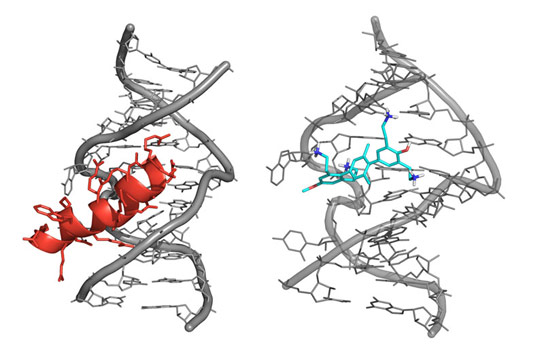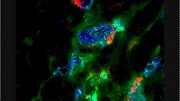
Researchers have developed small synthetic molecules that can bind to the genetic material of HIV, thereby blocking its replication. Credit: Luis González-Bulnes, et al.
(This article has been translated into English)
An international team of researchers has designed small synthetic molecules capable of binding to the genetic material of HIV and blocking its replication.
A multidisciplinary team of scientists from universities and research centers in Spain, led by Dr. José Gallego, a researcher at the Catholic University of Valencia “San Vicente Mártir”, have designed small synthetic molecules capable of binding to the genetic material of the virus AIDS and blocking its replication.
This achievement has been obtained for the first time in the world by a group of researchers from the Catholic University of Valencia, Prince Felipe Research Center, University of Valencia, and Instituto de Salud Carlos III. The work has been recently published by Angewandte Chemie International Edition, one of the most prestigious in the world in the area of chemistry journals.
The new synthetic molecules are designed to inhibit the output of the genetic material of the virus from the infected cell nucleus to the cytoplasm, so that virus replication is blocked and the infection of other cells is prevented.
The genetic material of the AIDS virus, or HIV-1, consists of ribonucleic acid (RNA), and encodes several proteins that allow it to penetrate the human cells and multiply within them. The new inhibitors of the virus, known as terphenyls, were developed by this group of scientists by a computer to reproduce the interactions of the proteins encoded by the virus, the viral protein Rev.
Thus, the terphenyls join Rev’s receptor in the viral RNA, preventing the interaction between the protein and its RNA receptor. This interaction is necessary for the virus’ genetic material to leave the nucleus of the infected cell and, therefore, is essential for the survival of HIV-1. The terphenyls cell nucleus blocks the output genetic material of the virus, preventing infection of other cells.
This discovery is the result of close collaboration between three research groups over several years. Scientists from the Catholic University of Valencia handled the computational design and verified experimentally that the PCTs were able to bind to receptor Rev on viral RNA and inhibit the interaction between this RNA and protein.
The molecules were synthesized in an organic chemistry laboratory at Santos Fustero Prince Felipe Research Center and the University of Valencia. Also, through experiments with cells infected by the virus, Dr. José Alcamí and his colleagues demonstrated that inhibitors block the replication of HIV-1 and inhibit the function of the Rev protein, thus confirming the validity of computer-generated models.
RELEVANCE OF WORK
Traditionally, pharmaceutical companies have focused on developing drugs that target proteins, since RNA receptors are considerably complex.
Although several naturally occurring antibiotics act at the level of bacterial ribosomal RNA, up to now it has not been possible to design a new computer-synthetic chemical entity that is capable of binding to a target RNA and formed by exerting a significant pharmacological effect. The terfenílicas structures identified in this study could open new avenues to address other therapeutic targets consisting of nucleic acids.
This work has been published as a hot or particularly interesting paper in Angewandte Chemie International Edition, which is one of the most prestigious chemistry journals in the world. After receiving a positive assessment by anonymous reviewers, these items are selected by the editors of the magazine based on their relevance in a field of high interest rapidly evolving. The results of the paper are summarized in one image of the magazine cover.
The authors of the paper, titled “Structure-based design of an RNA-binding p-terphenylene scaffold That Inhibits HIV-1 Rev protein function”, are Luis Gonzalez-Bulnes, Ignacio Ibáñez, Luis Miguel Bedoya, Manuela Beltrán, Silvia Catalán, José Alcamí, Fustero Santos and Jose Gallego.
The project is funded by the Ministry of Science and Innovation, Carlos III Institute of Health, Generalitat Valenciana, and the Catholic University of Valencia.
Reference: “Inside Back Cover: Structure-Based Design of an RNA-Binding p-Terphenylene Scaffold that Inhibits HIV-1 Rev Protein Function” by Luis González-Bulnes, Ignacio Ibáñez, Luis M. Bedoya, Manuela Beltrán, Silvia Catalán, José Alcamí, Santos Fustero and José Gallego, 25 November 2013, Angewandte Chemie International Edition.
DOI: 10.1002/anie.201309856









Be the first to comment on "Synthetic Molecules Capable of Blocking HIV and Its Replication"